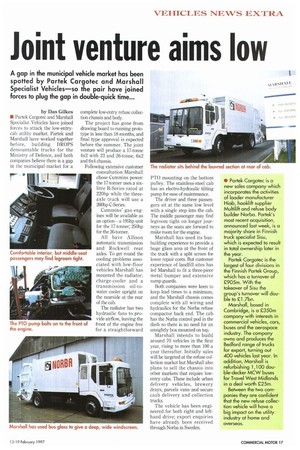Joint venture ai
Page 19

If you've noticed an error in this article please click here to report it so we can fix it.
slow
A gap in the municipal vehicle market has been spotted by Partek Cargotec and Marshall Specialist Vehicles—so the pair have joined forces to plug the gap in double-quick time...
by Dan Gilkes • Partek Cargotec and Marshall Specialist Vehicles have joined forces to attack the low-entrycab utility market. Partek and Marshall have worked together before, building DROPS demountable trucks for the Ministry of Defence, and both companies believe there is a gap in the municipal market for a complete low-entry refuse collection chassis and body.
The project has gone from drawing board to running prototype in less than 18 months, and final type approval is expected before the summer. The joint venture will produce a 17-tonne 4x2 with 23 and 26-tonne, 6x2 and 6x4 chassis.
Following extensive customer consultation Marshall chose Cummins power: thel7-tonner uses a sixlitre B-Series rated at 220hp while the threeaxle truck will use a 260hp C-Series.
Cummins' gas engines will be available as an option—a 195hp unit for the 17-tonner, 250hp for the 26-tonner.
All have Allison automatic transmission and Rockwell rear axles. To get round the cooling problems associated with low-floor vehicles Marshall has mounted the radiator, charge-cooler and a transmission oil-towater cooler upright on the nearside at the rear of the cab.
The radiator has two hydraulic fans to provide airflow, leaving the front of the engine free for a straightforward PTO mounting on the bottom pulley. The stainless-steel cab has an electro-hydraulic tilting pump for ease of maintenance.
The driver and three passengers sit at the same low level with a single step into the cab. The middle passenger may find legroom tight on longer journeys as the seats are forward to make room for the engine.
Marshall has used its busbuilding experience to provide a huge glass area at the front of the truck with a split screen for lower repair costs. But customer experience of landfill sites has led Marshall to fit a three-piece metal bumper and extensive sump guards.
Both companies were keen to keep lead times to a minimum, and the Marshall chassis comes complete with all wiring and hydraulics for the Norba refuse compactor back end. The cab has the Norba control pod in the dash so there is no need for an unsightly box mounted on top.
Marshall intends to build around 70 vehicles in the first year, rising to more than 100 a year thereafter. Initially sales will be targeted at the refuse collection market but Marshall also plans to sell the chassis into other markets that require lowentry cabs. These include urban delivery vehicles, brewery drays, parcels vans and secure cash delivery and collection trucks.
The vehicle has been engineered for both right and lefthand drive; export enquiries have already been received through Norba in Sweden.












































































































